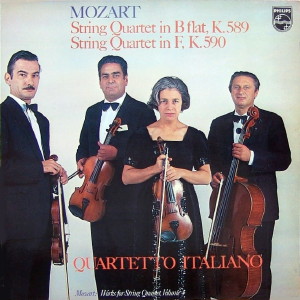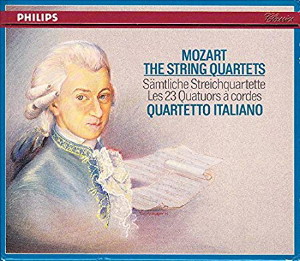 |
|
Philips
- 1 LP - 6500 225 - (p) 1972
|
 |
| Philips
- 8 CDs - 416 419-2 - (c) 1990 |
|
| Wolfgang Amadeus
Mozart (1756-1791) |
|
|
|
|
|
|
|
| String
Quartet No. 22 in B flat major, KV
589 |
|
23' 20" |
|
| -
Allegro |
6' 14" |
|
|
| -
Larghetto |
6' 34" |
|
|
-
Menuetto (Moderato)
|
6' 54" |
|
|
-
Allegro assai
|
3' 38" |
|
|
|
|
|
|
| String
Quartet No. 23 in F major, KV 590 |
|
27' 22" |
|
-
Allegro moderato
|
8' 46" |
|
|
| -
Allegretto |
7' 29" |
|
|
| -
Menuetto (Allegretto) |
4' 03" |
|
|
| -
Allegro |
7' 04" |
|
|
|
|
|
|
QUARTETTO ITALIANO
- Paolo Borciani, Elisa Pegreffi, violino
- Piero Farulli,
viola
- Franco Rossi, violoncello
|
|
|
|
|
|
Luogo e data
di registrazione |
|
La-Tour-de-Peilz
(Svizzera)
- 14-17
gennaio 1972 |
|
|
Registrazione: live
/ studio |
|
studio |
|
|
Producer / Engineer |
|
Vittorio
Negri
|
|
|
Prima Edizione LP |
|
Philips | 6500
225
| 1
LP | (p) 1972
|
|
|
Prima Edizione CD |
|
Philips | 416 419-2
| 8
CDs - (8°,
1-4, 5-8) | (c) 1990 | ADD
|
|
|
Note |
|
-
|
|
|
|
|
Mozart
composed these, his last
string quartets, in the
late spring of 1790, in
Vienna. A year or so
before, he had received a
commission from
Frederick William, King
of Prussia (not
Frederick the Great, but
his successor) for
half-a-dozen
quartets. Nizart was
pleased enough to
get the commission,
for, as usual, he
was hard pressed for
money. He composed
the first quartet
(K. 575) in June
1789, but it was
nearly a year before
he resumed the task
of trying to finish
off the whole set.
He wrote the second
(K. 589) in May 1790
and managed to get the
third (K. 590)
finished that
year, but that
was the last
quartet he was
to write. Worn
out by work and
worry, he does
not seem to have
been able to
summon again the
high
concentration
needed to write
in the
string-quartet
medium.
In
writing these
quartets,
Mozart was
constantly in
mind of his
royal
customer's
predilection
for the cello,
which was the
king's own
instrument - a
point which
has to be
remembered by
us in
listening as
much as it was
by Mozart
while
composing. The
overall result
of the king's
liking for the
cello is a
curious
displacement
of interest
from the first
violin to the
cello iteself,
which has an
unusual
preponderance
of good tunes.
STRING
QUARTET IN B
FLAT, K. 589
The
first movement
(in triple
time) opens
with a bold
first subject,
which merges
into a
strangely
chromatic
bridge passage
and so into
the second
subject, which
is of a Ländler-like
chacter, akin
to the waltzes
which were
just beginning
to establish
themselves as
the typical
Viennese
dance-form.
The cello has
the second
half of this
subject and
then the
exposition
ends with
scale passages
in triplet
figures. The
development is
quite long,
for Mozart: it
makes use of
all the main
subjects
before it
brings us back
to the
recapitulation
of the main
theme in the
home key. It
is perfectly
in order with
the origin of
this quartet
that the main
theme of the
slow movement
should be
given to the
cello, with a
murmuring
accompaniment,
until the
first violin
takes yp the
tune. The
order of events
is then
reversed: the
first violin has
the subsidiary
theme, the
cello repeats
it, and the
two then
exchange ideas
for the rest
of the
movement, with
the second
violin and the
viola
occasionally
putting in an
idea; however,
the melodic
ideas un
themselves are
so eloquent
that one is
inclined to
overlook the
actual
instrumentation
and listen to
the sheer
beauty of the
musical
thoughts. The
minuet is bold
and the trio
all
enchantment.
The eloquent
tunes are
tossed from
one instrument
to another -
but all with
the neatest
expertise.
Mozart's first
idea for the
finale was a
set of
variations,
but he changed
his mind, and
so wrote the
present
delightful
movement, a
sort of
galante huntig
jig; formally,
it is a rondo
of the most
ingenious
kind, as full
of
counterpoint
as a Bach
fugue.
STRING
QUARTET IN F,
K. 590
The
opening theme,
in unison, is
not perhaps
remarkable in
itself, except
that it comes
to an abrupt
stop in the
third bar.
But Mozart
then inflects
it, changes it
subtly and
then uses it
as a quite
melodious
bridge passage
to a cadence
which allows
the cello to
give us his
version of the
tune. This in
its turn leads
to the second
subject, which
is also given
out by the
cello, and
which turns
out to be
closely
related to the
first group of
subjects.
Indeed, this
movement is
far more like
Haydn than
Mozart, in its
economic use
of thematic
material. The
development
section makes
considerable
use of scale
passages and
leads directly
back into the
recapitulation,
wherein most
of the
subjects we
have already
heard are
brought back
to our
attention and
are concluded
with a brief
and tense
coda. Mozart
left two
directions for
the slow
movement - Andante
or Allegretto
- and the
latter has
been adopted
here. The
shape of the
movement is a
kind of sonata
form, with
quite a long
development
section for a
slow
movement. The
thematic
material is of
great beauty
and is fairly
equally shared
between the
four
participants.
Again, there
is a brief coda.
The minuet and
trio show the
usual contrast
with the
minuet bold
and masterful
and the trio
delicate
rather than
forceful. Then
come one of
the gayest
finales one
can imagine, a
sort of
Hungarian
gipsy rondo,
which is yet
in sonata form
at the same
time.
Everything is
in the highest
possible good
humour, and
one can
scarcely
believe that
Mozart
composed this
at a time when
he was filled
with anxiety
and care over
financial
matters. It is
indeed a
remarkable
triumph of
mind over
circumstances.
Charles
Cudworth
QUARTETTO ITALIANO
The Quartetto Italiano is
deservedly one of the most
renowned quartets of our
time. It was as long ago
as 1945, soon after
completing their studies,
that Paolo Borciani, Elisa
Pegreffi, Piero Farulli,
and Franco Rossi,
resisting the tempting
promise of individual
careers as soloists,
decided to pool their
youthful enthusiasm and
musical talent and devote
themselves to the
difficult but satisfying
art of playing chamber
music really well. By 1947
the group had established
a firm reputation in
the musical press and
begun giving concerts
outside Italy. In 1951
they visited the United
States for the first time,
and it was soon apparent
that their devotion to
their music and the
impeccable standards of
performances they had set
for themselves were
earning them fame as well
as satisfaction. Over the
years since 1945 they have
remained together, a rare
example of teamwork in
music and something unique
as far as quartets are
concerned. Teamwork in
performance, too has
contributed greatly to
their success. Their
principle of thoroughly
memorising their music and
playing wherever possible
without scores has enabled
them to perform with
astonishing unanimity and
a precision which is
unequalled in their field.
To list the group’s
wide-ranging activities in
more than 25 years is
pointless: they have done
everything one might
expect of one of the
world’s finest quartets.
They have given hundreds
of concerts all over
Europe and in the United
States; they are regular
partecipants in the
chamber-music concours of
many countries; and they
have played and are in
constant demand at the
world’s great music
festivals. Outside the
concert circuit the
members of the quartet
teach chamber music at
both the Royal Academy of
Music in Stockholm and the
Conservatoire in Vienna.
In addition to the many
words of praise bestowed
on them – after their
first concert in New York,
Virgil Thomson, the
distinguished critic of
the “New York Herald
Tribune,” called them “the
finest quartet,
unquestionably, that our
century has known” – they
have been publicy honoured
by the President of Italy
as a more tangible
recognition of their
outstanding artistic
services over the years
to Italy in
particular and the world
of music in general.
|
|
|